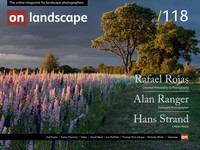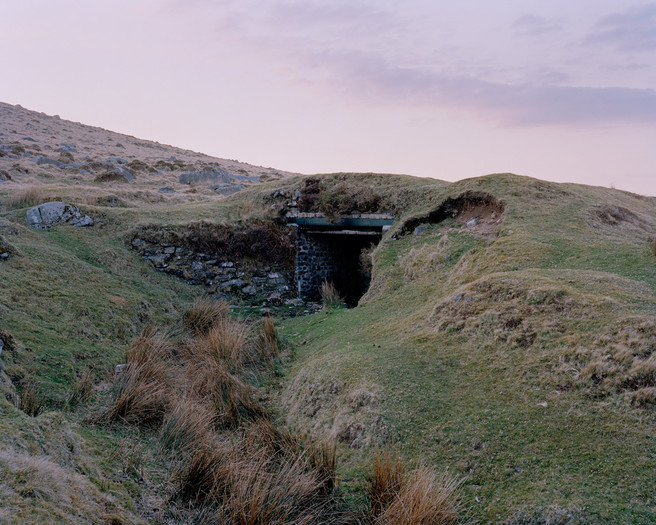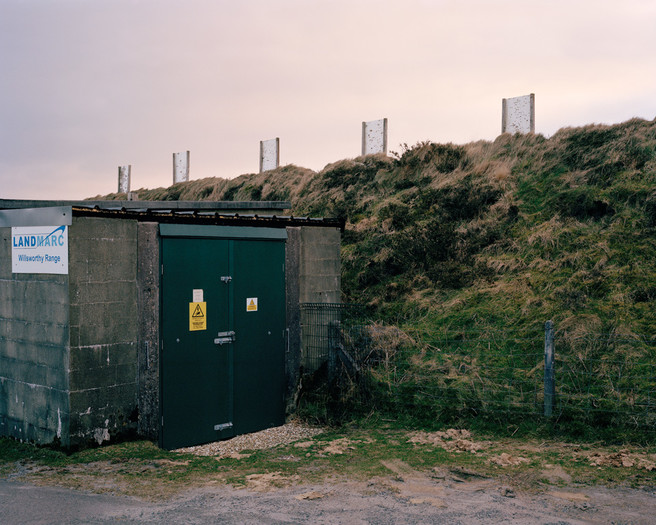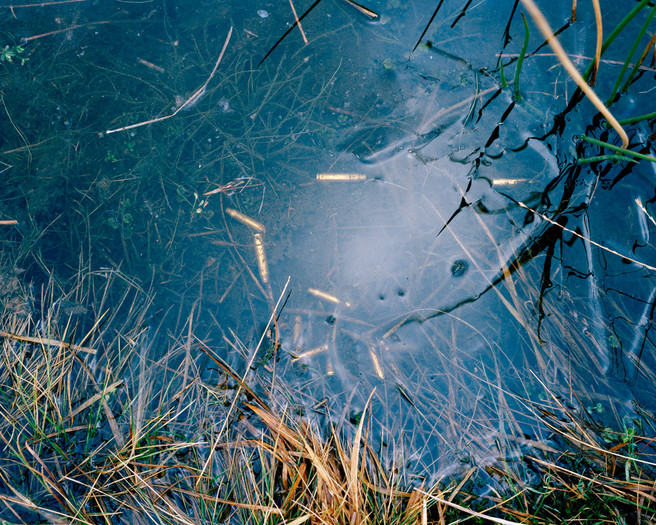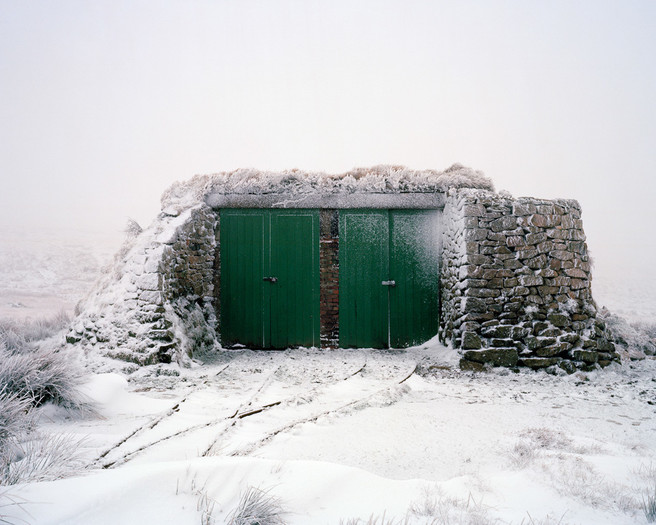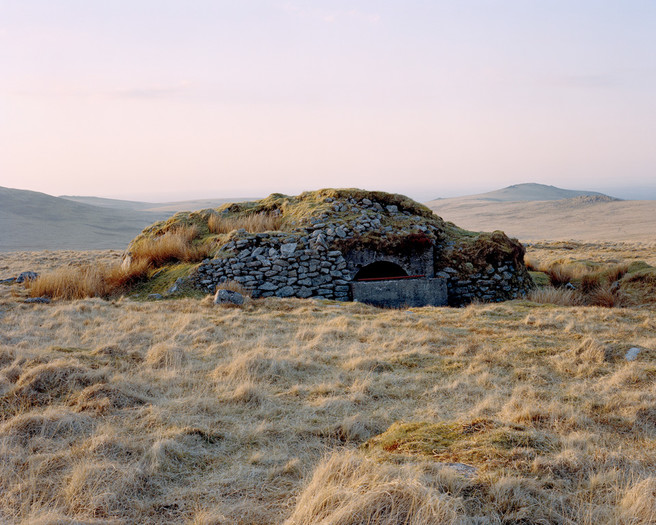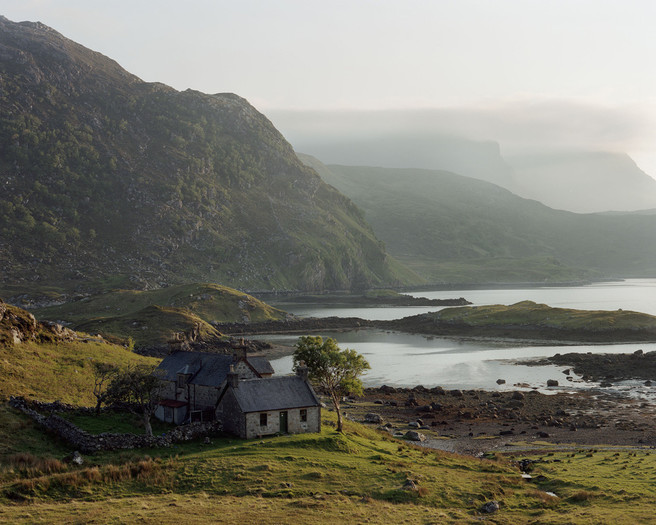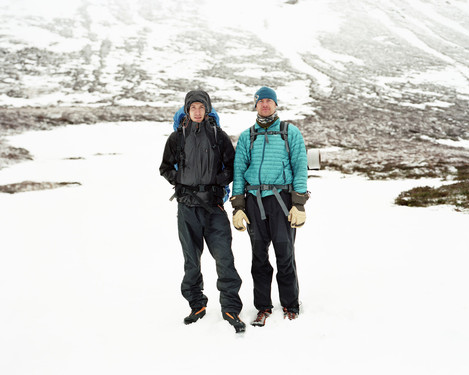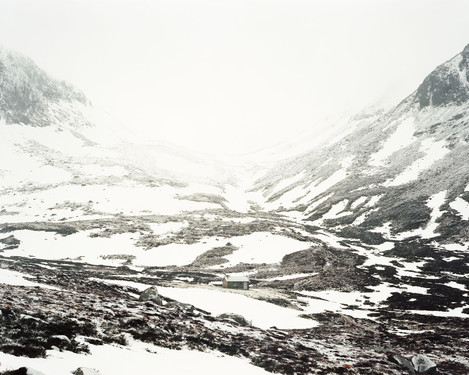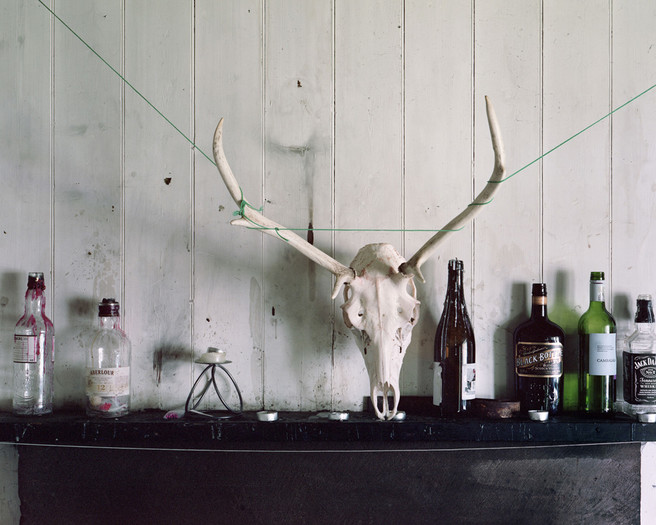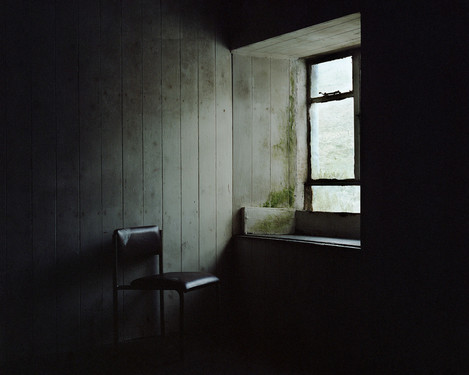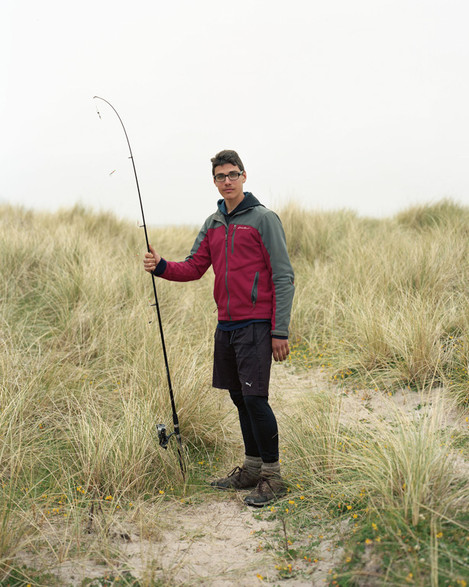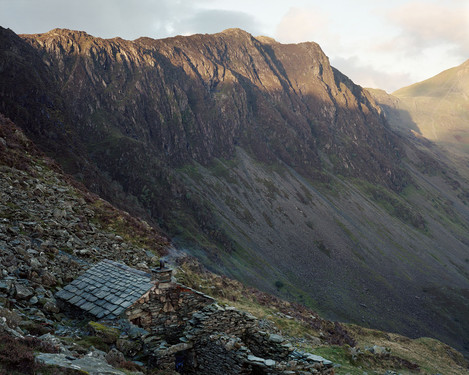From Militarisation of Dartmoor to Bothies

Nicholas White
Nicholas White is a photographer based on the edge of Dartmoor National Park in the South West of England. He graduated from Plymouth College of Art in 2013, was commended in Landscape Photographer of the Year 2015 and is an Associate of the Royal Photographic Society. He currently divides his time between a studio with no windows, and the landscapes of the British Isles. Nick's other website is http://www.blackdotsproject.co.uk/, Facebook, Twitter and Instagram.

Tim Parkin
Amateur Photographer who plays with big cameras and film when in between digital photographs.
I've been following Nicholas's photography since he started publishing his 'Militarisation of Dartmoor' series and when I saw he had started a new series on our bothy system I was intruiged to meet up and find out more.
Tim Parkin: Tell us about yourself then Nick
Nick White: Hi I’m Nicholas White, I’m a landscape photographer based in Dartmoor National Park in the South West of England. I’m 26 years old, graduated from Plymouth College of Art studying Photography in 2013 and ever since frantically tried to carve some sort of career in photography and still trying.
TP: Why photography originally and why study for a degree?
NW: Originally photography was born out of a love of the outdoors. I grew up in Dorset but my grandparents lived on Dartmoor and every single holiday was in Dartmoor National Park. I didn’t go abroad till I was 18 or 19 years old and even then I have only been abroad twice in my life unless you count Scotland!
Every holiday, Easter and summer holiday was spent on Dartmoor, walking, hiking and letter boxing. Do you know letter boxing on Dartmoor? It’s where geocaching came from, but it works with stamps and books,
I used to borrow the family camera and snap away. A bit of a cliche story! As I got older, I found it was a great way of documenting those walks and experiences, which felt like massive adventures at the time. Being able to bring them back and relive them again and show friends and family what we had done. Over time, that grew to the point where the walking element became secondary to the photography element. That then became the reason I was going out.
TP: Did you do art at A Level?
NW: No, I never planned on being a photographer at all. I wanted to be a musician, which was all I what I wanted to do; I played the drums and still play the drums. I studied A Level music, sound engineering, music technology and media. Photography at the time was a hobby, and then I found that by studying music, the thing I loved, it took the fun away. It became something I had to do.
My brother is a musician, and he went to university to study music, and he dropped out for that same reason. It became something he didn’t enjoy anymore. So I looked at that and saw that my brother was falling out of love with his music, leaving university and doing it for himself. He then fell in love with it again.
I finished A Levels and said, "I don’t want to do this, I want to keep it as something fun, what else have I got?". That’s when I looked at my photography and then went back and did another two years doing BTEC Photography at Plymouth College of Art. That progressed on to a three-year degree at Plymouth College of Art - to the point now where I don’t have the time to make music anymore; my photography has taken over!!
TP: I know Jem Southam is in Plymouth - have you got to meet him?Jem Southam is in Plymouth - have you got to meet him?
NW: I chatted with Jem a couple of weeks ago as I curated the Dartmoor Open exhibition at a local gallery. I volunteer for the gallery anyway, and Jem was one of the judges, and I bumped into him. We had a few teething problems with the emails, and he was quick to point them out. He’s a good guy, and we chatted about the On Landscape Conference, and he said the same thing I said. There’s this weird split in landscape photography between guys like Jem and guys like Joe Cornish. Two very different styles of landscape photography.
TP: How useful was that BTEC?
NW: The BTEC and the degree served two different purposes. The BTEC was more technically focused, how to construct a photograph, how to use a camera, which was beneficial for me as I had only really picked it up and fumbled about a bit. So understanding the relationships between the settings and where to position things according to the rules. The degree moved away from that and more about how you think about photography and the research side of it. It wasn’t a commercial photography degree; it was straight photography. It was more about the meaning behind things, the reason why constructing projects and narratives. A lot of people dropped out because of that.
TP: People found that difficult did they?
NW: I think they found that were sitting in a room, reading and couldn’t understand how that fitted in with them taking photos. For me, I did the three years, and it helped me massively. I still apply bits of that now, like the research that goes into my work.
TP: There is a point where you get past the basics of operating a camera where you ask “What am I doing this for?”. You could think photographers get past this stage quicker than painters because of the ease of getting competent, but that often isn’t the case.
NW: I question this, even when I’m out there doing it, and you’re standing there up to your knees in a peat bog having dropped my loupe in the mud! It’s minus five, what am I doing!! It’s always good to question it.
I think that, combined with the fact that I made that shift over to film, it was the degree that helped me. I initially made that move as I wanted to break away from the ‘pretty pictures’ and think about why I’m doing my photography.
TP: What happened when you moved over to film? Brave move some people would say!
NW: I know! When I was at the college I never even knew when I started that people still shot film. It was 2008, and I just assumed that digital was everything. At the college, there was this equipment store there, and I started renting out Hasselblads, the normal 6x6 but also the XPan; All the way up to Leaf digital backs - although I never got excited about digital backs. I remember I took out a Mamiya RZ67, with the revolving back. Just using it was amazing, forget the technical benefits, just setting it up and the clunk felt great. The move to 5x4 was arguably for technical reasons but mainly for the aesthetic look of film, and ultimately I love using those cameras.
On the degree, the digital guys were really into their Petapixels and were asking “why do I want to shoot film when digital is so much better?" I was like ‘fair play’, but I just enjoy the film experience. Even when I’m sitting there and I’m scanning them in, and I’m dusting it. I love the whole process.
You have such a close relationship with the final result when you see it in print, like at a show. It’s like, I spent hours walking to that location, waiting for it, and then sitting there dusting it away, etc.
TP: Can you remember every single picture you’ve taken?
NW: Every single one - I don't shoot many, so each one counts.
TP: I’m told one of the things that comes out of an art degree is your networking and the ability to start getting on the show and exhibition circuit. How did that go for you?
NW: There’s an opportunity for that to happen, but you have to make it happen for yourself. You have to build your momentum on the course as it’s easy to go out drinking every night, then finish, and all of a sudden no-one knows who you are. People then ask ‘no-one is looking at my work, why not?’ it’s because they don’t care, you have to show them and make them care.
For the final two years, I shot the same project, which was the Militarisation of Dartmoor. I started looking more at land use rather than pure landscape, and I was very into Simon Norfolk’s work. I chatted with Simon when I started the project so that you can pick up on that link between the military and the landscape. Not copied, but it inspired me massively. Richard Misrach and the project Bravo20 was another influence. It's an amazing story about this naval bombing range where he makes a mining claim, and he worked the area photographically but also had plans drawn up on how he could convert it into a national park. It’s an amazing book.
I’ve shot my project on Dartmoor for the past two years. In the second year, I shot the camp, the home of Dartmoor training and moved out into the landscape and did the three designated ranges in the National Park. I find it interesting how places so beautiful which are designated as having National Park status are also used as a practise area for war. You look at Salisbury Plain, which is an area of scientific interest because of the chalk, but tanks trail on it every day. It’s that weird combination.
The island off Cape Wrath that’s used for a bombing range which is now a bird nesting ground. It’s that weird juxtaposition between beauty and military.
TP: Did that open doors for you?
NW: I did that for two years, and I was pushing, pushing through social media. We were scouted by this local gallery which is where I had my show, as I had a massive amount of research and body of work. As soon as I knew the gallery were there, I latched onto them, like a sloth. I got a solo show off the back of that about six months after I graduated.
The way I saw it, I didn’t spend two years doing a project for it to sit on a hard drive and then to do something new felt like a waste of time. So I spent a massive amount of time making a press release of it and firing it off everyone and anyone I wanted to see it.
Off the back of that, I picked up some work for the Financial Times Weekend magazine and won a couple of competitions. It gained some momentum to the point where I was getting a bit fed up with it. The same photos were getting selected for publications again and again. It does open doors regarding my network of people I can contact for this new project. I could make the contacts but knowing how to approach them, having the confidence mattered.
TP: Shall we talk about militarisation and the Dartmoor project - Where did that start from? You obviously have a relationship with Dartmoor historically. When did you first start noticing these locations?
NW: The whole of Oakhampton Moor, Merivale and Wilsworthy are all military between Oakhampton and Princetown. My family came from Okehampton, and that’s where I grew up. More often than not, when you walk up into the moors, the red flags are flying, and you can’t go. When you’re filling up with petrol at the petrol station, you can see the trace rounds on the north moor. So you’re very aware of the military training going on. While I was on the degree, and I was thinking less about single beautiful landscapes, I was spending more time thinking about projects and narrative about the landscapes and land use. This landscape was where I went for walks.
TP: So you couldn’t not think about it?
NW: At that time I was reading a lot about Simon Norfolk's work, and I was thinking these landscapes that were damaged by war - many thinking about his Afghanistan work and Bleed. I started noticing things and then started thinking, could I transfer that to my landscape that I’m surrounded by, thinking about how that is used for this dual purpose.
TP: Summarise the project for me. If you were going to someone who didn’t know anything about it - how would you describe it?
NW: The main thing I was trying to look at was that juxtaposition between a landscape which is so beautiful, which has a sinister undertone to it which is the military bit. This project doesn’t get across this reflection, which I would have liked to and it’s this: When they are firing up there, and there’s a firing timetable, and there’s an old lady with her dog waiting at the gate. As soon as the army trucks come down, she goes up and walks her dog. Sadly I just don’t get that across.
I think ultimately it’s that dual use of the landscape whether you see it as a positive or negative as there are obviously environmental side effects such as boot prints, bullet casings, mortar rounds, and left over ammunition shells.
TP: Pick two or three pictures out of the project for me.
Bullet casings under ice
NW: This was on an anti-tank range which is about 1.5 hours walk from the road. At the very far end of the range, they have the targets and the landscape between the far end and the target is just pitted with holes and craters. This is also the area where they find unexploded ammunition from the rest of the range, they transport it here and detonate it here. They’ve built a pit and detonate it in there. Therefore being they’d rather have one area that is completely polluted than spread it around.
TP: I was going to say the pollution must be a big thing, with some rounds going off. Talk to me about the Green doors
Wickham target trolley shed
NW: This is a - it was an amazing day to be out. This area is usually pretty battered by the wind and on this day there were loads of snow. It was freezing fog and not a breath of wind - I was shooting on a 5x4, so it made that easy! I already knew about these green doors - I knew it was foggy, so it was the right weather for this photo. This shed used to have a trolley that sat inside. It had a fake tank that sat on this trolley, and it got remotely sent along these tracks around a figure of eight. These guys would launch shells at it from the camp. It’s now just a storage hut that I’ve rarely seen opened. So it’s defunct in many ways and turning into a relic, but people know about it, it’s on the map. Hikers use it for navigation; it’s below Yes Tor which is one of the highest points.
Observation Huts
NW: These along with the next one which are observation huts. Each designated firing range has got one of these huts on it, that they’ve tried to build to merge into the landscape. Which looks like something out of The Hobbit or something. There used to be about twenty of these, but they were instructed to remove them as they are a blot on the landscape. How did they remove them? They chucked them full of dynamite and blew them up!! So there are now about eleven craters.
TP: Are these the same things?
NW: This is now an observation hut but these used to be a train track that came in. The target used to live in that too, and it came out and was pulled by horses down by the camp. There were ropes and pulleys - but from one side you don’t even notice it.
TP: When I am looking around these there is a range of detailed shots and interiors, wild landscapes. Regarding the editing process, how many pictures did you take for the whole project would you say?
NW: There are about fifty in the camp, which are my building shots, and those are shot on medium format. That was my second-year project. The third year I think I shot about the same again regarding sheets of film for 5x4. Originally they were two separate projects and when I finished the second one I edited it right down into one study. With the intention of giving a rounded view of the landscape out of the moors but also the relative comforts inside the camp. In terms of shooting on film, I’m already editing it while shooting it.
It was painful to remove some of the shots as I like to think that they were removed for a reason. So it’s made the project stronger by removing them.
TP: Aesthetics - we talked earlier on about conceptual and sublime / romantic photography. Are you thinking about aesthetics when you’re taking these pictures? Are you trying to bridge the divide? Engage the audience?
NW: Bridging the Divide is a good way of wording it. I enjoy shooting in bleak conditions, embracing a much softer and more subtle aesthetic. This worked especially well for the Dartmoor work. I'm a fan of building narratives, telling stories through a series of photographs which lends itself more to the conceptual arena of landscape photography. I enjoy the works of Southam, Schutmaat and Soth. But with that said, because of the origins of my photography I'm still a huge fan of romantic landscape photography and adore the work of photographers such as Joe Cornish, David Ward and Charlie Waite. I don't think there's a need to take sides, or exclude an entire movement of the genre. I think it's ridiculous that this divide even exists. I hope that my latest work highlights my passion for both styles.
My dream project would be something that has this story/narrative that ties it all together. It tells you a story but at the same time, someone who doesn’t buy into any of that, can pick an image out and have it on their wall. You can’t do that with this, as no-one is going to want a military shelter in mist on their wall.
TP: Tell me about the black dots project then as that sounds like it might fit.
NW: I have this habit of getting excited on social media - as I want to show someone the project I’m working on. So I’m sitting on a load of scans at the moment. This project is the next series on from Dartmoor, which has taken me probably two and a half years to start a new series.
TP: Is this when you got fed up of promoting the last one?
NW: I wanted to make something which was purely about embracing things that I loved. I didn’t want to be "that military landscape guy", I want to go into the landscape and explore these wildernesses of the UK. But then it was "how am I going to do that and tie it into a series". I then found out about bothies.
TP: They don’t have bothies on Dartmoor?
I looked at the landscapes they sit within and read that they are left open all of the time. You can go in and be on your own for a night or meet a complete stranger. That tied it all together - so the protagonist is the bothy, it’s about mountain bothies, it goes deeper than that. It’s more about how we use the landscape and how we enjoy the landscape. These bothies represent a whole way of people who find joy and fulfilment going out into the wilderness.
I’m in the early stages really, and I’ve photographed Lake District, Snowdonia, Cairngorms and Skye. Already the people I’ve met, and the friends I’ve made from it are amazing. I’m mixing portraits in with this project of people that I meet. I’ve made portraits of people from German Alpine climbers to an ex-SAS Sniper Rifle chap to an author who’s written books on Morris Dancing in Castles and everyone in between.
These people who come from an entirely different walk of life to you. It doesn’t matter who job they have or what car they drive. When you go out there, and open the door and you have a fire and a gas stove on and a cold beer in your bag, you’re best mates already! You can just chat about what Monroes they’ve been up. You look at maps, routes and the next day you shake hands and sometimes make a portrait if they are willing. You then go your separate ways - I find that extraordinary.
TP: Are you joining the portrait aspect with the landscapes or keep them quite separate.
NW: Absolutely, the bothies wouldn't exist if it wasn't for the people. It's the first time I've shot portraits for a personal project, but they're quickly becoming an integral part of the narrative.
I don’t go with any rigid plan, sometimes the bothies look amazing, but they don’t work as an image, but then there might be something inside it that works. There was someone in the Hutchison Memorial Hut that had written a poem and drawing pinned it to this wooden clad wall. That sums up this bothy for me. I go out with a box of film and shot what I feel needs shooting, and at the end of it all, I’ll group it all together.
TP: How long do you see this going on for?
NW: I want to shoot through this winter - I want to avoid Scotland in summer as I’ll get eaten alive! Then shoot through autumn and winter, with the intention of beginning of 2017 that’s when I’ll start the editing process.
TP: Can we see a couple of pictures from it?
NW: Yes, I’ve got quite a few to share! What my thoughts behind this journal were, that when I finish the project, you don’t get a sense of my story. The story of the guy called Andy who comes out with me and documents the process with me - you don’t get a sense of that. When you see an image of a bothy, as a viewer am I standing in a lay-by? Have I hopped over a fence? This journal acts as a behind the scenes to get the message across and the process of the project.
TP: The Attenborough programmes have proven there is an interest in that.
NW: The frames at the end? Yes, people want to feel that they’ve been a part of it, and they’ve been on the journey. It’s a glimpse into the life that you lead on the project.
I see a lot of projects, and I think about how I want to know how he did that. Not what his settings were, or what lens, but the thoughts behind it. How did he get to that? This gets across the lengths that we go to for two shots.
On one of the days in an area, I’ll leave the 5x4 in the car, and we’ll do a days climbing in the area that we’re shooting. Which ends up on the journal as it’s part of the project.
Crib Goch we did the whole ascent in the dark. We planned to get to the summit for nightfall and do the descent with head torches. It was a ropey walk back.
It’s a tradition of ours to carry out a bottle of Jail Ale from Dartmoor to each bothy, and we’re going to send the photos to the brewery as a memento.
TP: I can see from the photos the amount of equipment you take.
NW: I’ve got a people carrier and have taken out the back seats as I have slept in the back of it when I couldn’t make it. Obviously, I could stay in bothies but the amount of photography equipment I’m sometimes taking it’s not possible to take out everything you need for a couple of nights in the mountains as well. Having that worry that it’ll be trashed as well, I get funny about it, so I used to sleep in the car. Now we hostel where we can or book a hostel room a week and not stay there, but it’s somewhere to store the kit.
I’ll take the camera kit and put the outdoor kit in a trunk in the back. We don’t travel too light!
TP: What photographic gear do you use?
NW: Large format I use a Chamonix 045N-2. It's taken a bit of battering, but it’s beautiful. Lens wise it’s a Schneider 150, but I haven’t just stuck to Schneider. Most of the stuff has been shot on a 150. It’s a natural perspective, but I do have Nikon 300mm in there too. It’s not the heavy one it’s the M one. Schneider 210 as well and a 75, but it never really leaves my bag.
Digitally I travel with a D810 with a 24-70 and some Lee Filters if I see something I want to shot.
TP: You shoot neg film?
NW: Kodak Portra 400 is my go to. The tonality of it, the amount you can push those highlights if you want to especially if I’m shooting the white out conditions. The high end of the film is incredible. I’ve got an Epson V800 scanner just mainly for contact sheets and then use an Imacon from the University once I’ve decided on the ones I want to use.
TP: So you wanted to make money when you left university - you had to make a choice about how you approached your projects. Get a good job that has a good wage so I have a small amount of time but I’ve got the funds to do stuff. Or do I have a job with a lower wage, but the time to do the projects.
NW: The time versus money argument, you can’t have both. I’ve been fighting with this for a while. I’ve been lucky enough as I’ve won a few things through ideatap and the magnum professional practices weekends I won one in London and one in Birmingham, that’s when I got to know Emma Birkett from the FT weekend.That was one of the main topics which were how to fund your practice, and everyone was saying that they worked full time so they had the money but not the time. A lot of guys said they had taken the leap of faith and stock piled funds and worked on odd jobs.But I’ve found myself a full-time job in photography which had made it harder for me as I live in Devon, and I have a full time in photography, which doesn’t leave much time or a good location to access bothies very well!
TP: How did you get that job in the first place?
I’m working full time as a photographer, I take on web stuff and website building and do bits and bobs. Some commission and freelance work, and I save, save, save. I moved back home with my family who are fine with it after I’ve explained it to them that I want to focus on my photography career. I’m in the process of selling my drums and all my music stuff off. You have to give it everything I think, so I’ve moved home, sacrificed my independence, and selling my drum kit, my other passion after photography. Eventually, I’ll have to cut it off and live out of my car for a bit as I finish off this project. I’ve been so inspired my people I have met on the road doing this, especially European travellers, travelling on their own. I ask how they survive. They say they sleep in their cars or bothies. They do it, just do it. As soon as you start doing it you have to roll with it; it’s what my brother did with his music, and what I intend to do with my photography.
Insurance on a car is less than rent, so that will inevitably be a deciding factor. I’ll keep all my computers back home and head off. I’m running out of bookable holiday anyway and have got ten days left plus weekends for the rest of the year. That’s not a whole lot to finish off the project? I’ve already invested so much in this project - all the outdoors equipment and photography equipment. It deserves so much more than ten days, so it’ll be a case of slogging through the summer and then beginning of Autumn plunge into it.
TP: When the nice light starts?
NW: Yes that’s so right. There’s nothing worse than leaving work and it’s wonderful light. Everyone says you won’t make money in landscape photography, and I always say "have you tried it? How do you don’t know if you haven’t tried it?" I’d rather look back and say I’ve tried and failed rather than never tried at all I think.
TP: It’s not necessarily about making money, you can always live somehow
NW: I am and I can. I met this German guy who was doing it, and he said I don’t eat what I want, I eat what my body needs. He’ll spend so little money when he’s travelling as he eats what he needs, no luxuries, no treats and gets it done. That’s what I intend on doing.
People all over the world do it. It’s that initially leap of faith and just doing it. Civilisation is a trap, it is.
TP: The more you earn, the more the trap closes.
NW: The more directdebits you have, like a photo contract, it’s hard to get rid of them. That’s my plan anyway. It will make an interesting story to blog about.
TP: It’s an impressive plan, and we'd love to hear more from you in a year or so!! Thank you very much for your time.

